Bernard Picart
Bernard Picart (11 June 1673 – 8 May 1733), was a French engraver, son of Etienne Picart, also an engraver. He was born in Paris and died in Amsterdam. He moved to Antwerp in 1696, and then spent a year in Amsterdam before returning to France at the end of 1698. After his wife died in 1708, he moved to Amsterdam in 1711 (later being joined by his father), where he became a Protestant convert and married again.[1]

Most of his work was book-illustrations, including the Bible and Ovid. His most famous work is Cérémonies et coutumes religieuses de tous les peuples du monde, appearing from 1723 to 1743. Jonathan I. Israel[2] calls Cérémonies "an immense effort to record the religious rituals and beliefs of the world in all their diversity as objectively and authentically as possible". Although Picart had never left Europe, he relied on accounts by those who had and had access to a collection of Indian sculpture.[1] The original French edition of Cérémonies comprises ten volumes of text and engravings.
Israel notes also that Picart left Paris with Prosper Marchand,[3] and collaborated on the Cérémonies with Jean-Frédéric Bernard, with a commitment to religious toleration. Picart, Marchand and Charles Levier belonged to a "radical Huguenot coterie".[4]
Works
"Cérémonies" engravings

- Vol. 1: (1727) Asie, Afrique and Amérique (Asia, Africa and America)- 30 engravings
- Vol. 2 - 33 engravings (1727)
- Vol. 3 - 19 engravings (1728)
- Vol. 4 - 14 engravings (1729)
- Vol. 5 - 26 engravings (1736)
- Vol. 6 - 45 engravings (1738)
- Vol. 7 - 58 engravings
- Vol. 8 - 5 engravings
- Vol. 9 - 24 engravings
- Vol. 10- 12 engravings
The Temple of the Muses
This was an illustrated book of Ovid's more popular fables published in 1733 in Dutch (Tempel der Zanggodinnen), in 1738 in English, and in 1742 in French by Zacharias Chatelain. The engravings had captions in French, English, German, and Dutch. The artists involved were Michel de Marolles, Bernard Picart, Jacques Favereau, Abraham van Diepenbeeck, and Cornelis Bloemaert. A facsimile of the Dutch version was published in 1968.
_a_celebration_of_the_birth_of_a_child%252C_(right)_the_ch_Wellcome_V0015967.jpg.webp)
Notes
- Grove Art, accessed 26 May 2007
- Israel, 2001, p.135.
- Israel, 2001, pp.575-6
- Israel, 2001, p.696.
References
- Grafton, Anthony. "A Jewel of a Thousand Facets." New York Review of Books (June 10, 2010) Vol. LVII, number 11. Page 38–40. Online summary
- Hunt, Lynn, Margaret C. Jacob, and Wijnand Mijnhardt. The Book That Changed Europe: Picart and Bernard's "Religious Ceremonies of the World" (Harvard University Press; 383 pages; 2010).
- Hunt, Lynn and Margaret Jacob and Wijnand Mijnhardt. Bernard Picart and the First Global Vision of Religion. Los Angeles: Getty Research Institute, 2010.
- Wyss-Giacosa, Paola von (2006). Religionsbilder der frühen Aufklärung : Bernard Picarts Tafeln für die Cérémonies et coutumes religieuses de tous les peuples du monde. Wabern (Switzerland): Benteli, 2006. OCLC 65207871 See also Margaret Jacob, 'The Radical Enlightenment' (London:George Allen & Unwin, 1981).
- Israel, Jonathan I. (2001). Radical enlightenment: philosophy and the making of modernity, 1650-1750. Oxford: Oxford University Press. OCLC 44425436
- Jacob, Margaret, Bernard Picart and the Turn to Modernity, De Achttiende eeuw, vol. 37, 2005, pp. 1–16.
External links
| Wikimedia Commons has media related to Bernard Picart. |
| Wikisource has original works written by or about: Bernard Picart |
Bernard Picart and Jean Frederic Bernard's Religious Ceremonies and Customs of the World on UCLA website.